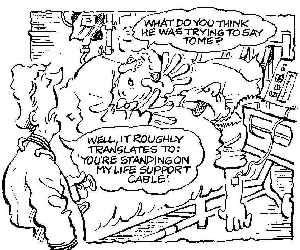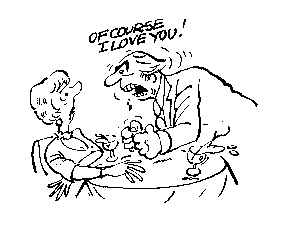 |
THE BUSINESS OF COMMUNICATION
by Terry Goodwin
It is a common fallacy that communication is simply the use of words to describe what we want to convey to others.
In fact we are continually communicating, even when we are unaware of doing so. Our output is via speech and body language; our input is via our sensory systems, particularly those of sight, sound and feeling. But communication, to be effective, is a two-way process. It consists of a message being given and a message being received. Thus a spoken message to a deaf person who cannot lip-read does not constitute a communication. A shrug or a gesture with the hands would be much more effective in such a situation. Contrarily, body language would be totally ineffective with someone who is blind, yet speech unaccompanied by the body language or facial expressions that frequently aid meaning, might equally result in a failure to communicate a precise message.
 |
When we consider the importance of communication in business we need to appreciate that success or failure can reflect the effectiveness of the communication skills that are employed. Communication needs to be open and honest in order to build trust; it needs to be equally effective on verbal and non-verbal levels; it is as important to listen and to observe as it is to speak.
In the system of psychology known as Neuro-Linguistic Programming (NLP), this situation is covered by one of its principles (or presuppositions), namely “the meaning of a communication is the response it elicits”.
An intended communication is not always what is understood by the other person. When this happens, the intention of the speaker is irrelevant; what is important is the message that is received; and the message is generated as much by body language and tone of voice as the words themselves.
Let's take a simple example.
 |
What do you think is the message being conveyed by the man in this illustration? If we are to judge by the words alone it is one of love and caring and reassurance. It is doubtful, however, if the woman is feeling reassured. The words, in fact, are at total variance with the body language. In NLP terms this is known as incongruence.
How do you think a prospective customer might feel if a sales representative started thumping the desk and insisting "Of course I'm offering you the best package in the world!" As was said above, communication must be open and honest if it is to build trust; and the open-ness and honesty have to be expressed on both verbal and non-verbal levels. It is important, in other words (to use another favoured NLP expression) to achieve rapport.
Rapport is a process of building a relationship of mutual trust, harmony and understanding. It means meeting others in their model of the world. It means being on the same wavelength and connecting mentally and emotionally. It doesn't mean necessarily having to agree entirely with the other person, but simply knowing where they are coming from. It is achieved when two people can see each other's viewpoint, appreciate each other's feelings, and effectively put themselves in the other's shoes.
In this context, let us consider another NLP presupposition: "there is no failure, only feedback". When a communication elicits a totally incongruous response it is, perhaps, time to ask oneself if the response was induced by our own failure to communicate effectively rather than (as there is a tendency to do) assume that the listener or interlocutor is having a problem. Reverting to the picture above, it could be that the incongruent behaviour being exhibited was induced by an "inappropriate" message that had been received. It is, however, incumbent on both parties in a dialogue to be aware of the need to be in harmony . . . to achieve rapport.
Thomas Edison is reputed to have said: "I have not failed. I've simply found 10,000 ways that don't work." Apparent failure to communicate is merely an indication that another way has to be found.
"Every behaviour has a positive intention" is yet another NLP presupposition. This is based on the recognition that we all have different models of reality . . . different maps for the same territory. Somebody's words or behaviour that make no sense to us are more than likely to be merely the "right" way for them, given their model of the world. Instead of reacting instinctively to behaviour that we find strange, hurtful, or inappropriate, we might try to comprehend that this may be the best way the other person will behave given the resources available to them. What we have to do is to look behind the words or the behaviour to try and find the positive intent.
So what was the positive intent behind the behaviour of the man in the picture, thumping the table to indicate love? Possibly the incongruent behaviour resulted from frustration; an inability properly to connect; a sensitive button being pressed; or a reflex response being triggered. The moment we try to understand that there is a positive intention, we are on the way to understanding the person and to establishing rapport. And the moment we understand that, we can recognise that it is incumbent upon us to try and find another way to help the other person achieve their positive intention and for us to achieve our desired outcome.
It should not be forgotten that we are each in control of our own minds. Nobody else can choose our values and our beliefs for us - although they may try to influence them - so our model of the world and the way we experience different events is within our ability to change to a different perspective. A useful exercise is to consider how each of the above presuppositions might affect (or have affected historically) the things that happen to us, or have happened in the past. My notebook has the following suggestions taken from a course I followed many years ago:
1. Try to incorporate these presuppositions into my life by selecting a different one each day and applying it whenever an opportunity arises to improve rapport with another.
2. Recall a situation in the past when I might have done better in communicating my desired outcome or in comprehending that of someone else. Examine the situation in the light of each presupposition. Establish what this tells me about myself and what options are available to me should a similar situation arise in the future.
The art of influencing without manipulating, achieving rapport, and respecting another person's integrity while maintaining your own is known as dovetailing outcomes. Conflicts occur because we have different models of the world even though we may have similar outcomes which we fail to recognise through poor communication.
The concluding paragraphs of Genie Laborde's wonderful book[2] states:
"When we choose to dovetail our outcomes with others, we are choosing personal integrity . . . seeking ways to dovetail avoids manipulation and protects you from resentments, recriminations, buyers' remorse, and revenge. Dovetailing is simply more practical and intelligent than manipulating . . .
"To influence well and in an appropriate way has been the concern of thinkers through the ages. Now we have superior tools for influencing. The use of these tools and the integrity of that use is in your hands."
![]()
[1] Terry Goodwin was a senior marketing executive at Finexport Ltd in London and Bangkok until his retirement in 1992, since when he has been in private practice as a marketing consultant.
[2] Influencing With Integrity, Syntony Publishing, 1983.
NOTE: Illustrations in this article are by the late Albert Saunders and are to be found in An ABC of NLP by Joseph Sinclair (ASPEN, London, 1992. Revised and with additional material by Stephen Bray, 1998). The book is recommended for elegant definitions of the NLP "jargon" used in this article.